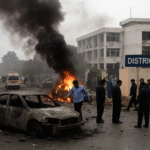Natural disasters have always fascinated and frightened mankind. Among them, cloud burst is one of the most devastating and sudden phenomena. In recent years, cloud bursts have been reported in mountainous regions such as Kashmir, Gilgit-Baltistan, Himachal Pradesh, and Uttarakhand, causing massive flash floods and loss of lives. While modern science is still exploring the causes and effects of this phenomenon, the Holy Quran already described such events more than 1,400 years ago as signs of Allah’s power and warnings to mankind.
In this article, we will explore:
- What is a cloud burst?
- Why and how does it happen?
- The disasters it brings.
- References to such phenomena in the Quran.
What is a Cloud Burst?
A cloud burst is an extreme rainfall event in a short span of time over a small geographical area. The Indian Meteorological Department (IMD) defines it as rainfall exceeding 100 mm (3.9 inches) per hour in a localized region. Unlike normal rain, cloud bursts release water with such intensity that the soil and terrain cannot absorb it, leading to sudden floods.
Why Do Cloud Bursts Happen? (Scientific Explanation)
Science explains cloud bursts through the following process:
- Formation of Cumulonimbus Clouds
- Large thunderclouds (cumulonimbus) form due to intense heating and rapid upward movement of moist air.
- Geographic Conditions
- In mountainous regions, warm air currents push moist air upwards where it condenses quickly.
- Sudden Release of Rainfall
- When the cloud becomes overloaded with moisture, it collapses suddenly, releasing massive rain in minutes.
- Triggering Factors
- Climate change, rising temperatures, and deforestation are increasing the frequency of cloud bursts.
Disasters Caused by Cloud Bursts
A single cloud burst can bring catastrophic destruction:
- Flash Floods: Sudden torrents of water sweep away villages, roads, and bridges.
- Landslides: Heavy rainfall destabilizes mountainsides, causing deadly landslides.
- Loss of Life: Hundreds can perish within minutes.
- Agricultural Damage: Crops, fields, and livestock are destroyed instantly.
- Infrastructure Collapse: Roads, power lines, and communication systems are disrupted.
Recent examples include:
- Leh, India (2010): A cloud burst killed over 200 people.
- Neelum Valley, Pakistan (2019): Flash floods due to a cloud burst washed away dozens of homes.
Cloud Burst in the Light of the Quran
The Holy Quran mentions heavy rain and destructive floods as signs of Allah’s might and warnings to mankind. While the term “cloud burst” is not explicitly used, the descriptions of sudden, overwhelming rains match this phenomenon.
Quranic References:
1. Surah An-Nur (24:43)
“Do you not see that Allah drives clouds? Then He brings them together, then He makes them into a heap, and you see the rain emerge from within them. And He sends down from the sky, mountains [of clouds] within which is hail, striking with it whom He wills and averting it from whom He wills…”
🔹 This verse describes cloud formation, accumulation, and sudden heavy rainfall, a process modern meteorology confirms.
2. Surah Al-Baqarah (2:19)
“Or [it is] like a rainstorm from the sky within which is darkness, thunder, and lightning; they put their fingers in their ears against the thunderclaps, in dread of death…”
🔹 This verse highlights violent storms with heavy rainfall, thunder, and lightning, resembling cloud bursts.
3. Surah Ar-Rum (30:48)
“It is Allah Who sends the winds, so they raise the clouds, then He spreads them in the sky as He wills, and He makes them fragments until you see rain emerge from within them…”
🔹 The Quran’s description of fragmented clouds suddenly releasing rain aligns with the modern definition of a cloud burst.
Cloud Burst: A Scientific Phenomenon and a Divine Sign
The Quran clearly connects such phenomena with Divine Will. Science explains the how, but the Quran explains the why: as a reminder of human limitations before nature and Allah’s power.
Cloud bursts, while scientifically studied, remain unpredictable. Their destructive force reminds us that despite technological progress, mankind is still vulnerable before natural forces.
Conclusion
A cloud burst is not just a meteorological phenomenon but also a Quranic reminder of Allah’s majesty. Science may measure the intensity, but the Quran revealed the process centuries before. As these events increase due to climate change, humans must take both scientific precautions (early warning systems, disaster planning) and spiritual lessons (reflection, humility before Allah).









